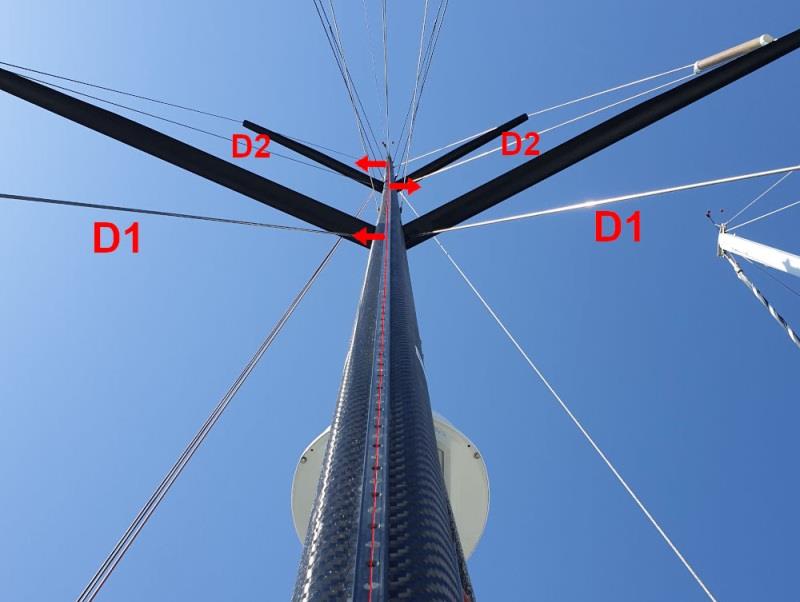
Global Solo Challenge: Standing rigging - Step by step guide on how to tune it on your sailboat
by Global Solo Challenge 16 Aug 2021 03:56 PDT

A badly tuned mast on a Class40 © Global Solo Challenge
Standing rigging: the evolution of rig types and their tuning
Historically, the most traditional rig type is the masthead one. That is with the forestay and backstay attached to the masthead as fixed standing rigging that create traction in the opposite direction. The spreaders, in this case, are in line, perpendicular to the fore and aft axis of the boat. With a masthead rigged boat, the backstay can be used to increase forestay tension in high winds. At the same time, by vertical compression of the mast, tensioning the backstay causes a bending of the mast that flattens the main. The backstay is both an element of the standing rigging but can also be tuned.
Tensioning the backstay, the central part of the mast advances forward creating a slight "C" shape of the mast seen from the side. This curvature lets you bring the "fat" of the mainsail forward flattening the sail. Therefore, with a strong breeze, we can intervened on the backstay to reduce the forestay sag and flatten the mainsail. Both operations improve upwind performance.
Fractional rigs
For decades now, however, "fractional" rigs with swept back spreaders have been increasingly widespread. In this case the forestay does not reach the masthead but only up to seven eighths or nine tenths of the mast height and so do the attachments of the shrouds. The spreaders are not perpendicular to the fore-aft axis but swept towards the stern on the horizontal plane. The swept back spreaders ensure that the mast can stand up even without the backstay, which is no longer "structural". That is, it is no longer one of the elements of the standing rigging (albeit adjustable). It becomes simply the means to adjust the mast bend and curvature and would be considered and its control line is therefore part of our running rigging.
This development has become more and more marked with boats with very wide spreaders and without backstay. The evolution started with offshore sailing boats such as the Mini 650s and Class40s and now it is very widespread also among cruising sailboats. By completely eliminating the backstay from the the list of elements constituting our standing rigging, which presented itself as an obstacle to increasing the roach of a mainsail, it is now possible to have all the roach we want and even "square top" mainsails.
Standing rigging tuning on fractional rigs with swept back spreaders
We will talk here specifically about boats with swept back spreaders. We have chosen a Class40, a sister-ship of the boat with which I competed in the Global Ocean Race 2011/2012. It's a popular model of Class40, a first generation Akilaria RC1, designed by Mark Lombard, from around 2006. The rig of this boat is not particularly "extreme" or delicate, being the Class40s designed for great ocean navigation. The standing rigging is all rod on this boat.
Although the mast is made of carbon rather than aluminium, the rig is the same as that of a Mini 650 Pogo2 from Structures shipyard. The Pogo 2, designed around 2003-2004 is the Mini 650 with most boats built. This type of rig, nine tenths fractional, has two orders of spreaders. There is no backstay at all, which is common on many modern boats. By now, I would say, even on cruising boats it is one of the most common rig arrangements. It is adopted by shipyards such as Jeanneau and Beneteau, even for boats without oceanic ambitions.
This type of rig is fitted with a runner at the mast top and a checkstay at the height of the inner forestay. Runners and checkstays are not structural, therefore are not to be considered part of the standing rigging per se, the mast does not need them to stay up. I jibed without runners in 50 knots of wind and nothing happened. That said, runners and checks play a very important role in stabilising the mast and reducing its stress. When I run my training centre I used to say that they were not part of the standing rigging but that for good practice we would treat them as such.
Continue reading the article here...